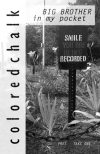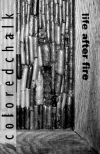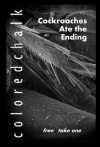The second annual issue of The Literary House Review has just been released. Why should you care? My story, "The Camp," appears within. That's why. Never mind that the publication contains 232 pages of genre and non-genre, commercial and literary fiction, along with poems enough to erect a mansion - albeit one inconveniently susceptible to moisture (guess what paper, you make a better art medium than a wall!). Never mind that The Review is available to buy here or here and is archived at New York Public Library, Rockefeller Library at Brown University, RI, and at the University of Wisconsin Madison Library (those are monocle-level smart houses, people). Buy it for "The Camp." Now for the author notes: As so many stories begin, "The Camp" was a self-inflicted dare. The concept of "The Camp" is seeded in a desire to explore the horrid through a lens subjectively aimed toward beauty.…
Category Archives Marketing & Promotion
I've been clicking over to 3:AM Magazine for quite a while now. I can't remember where I first heard about it (probably from Dogmatika, where I hear about most every great thing in the underground lit scene), so I can't place praise with full accuracy. However, I can pass on the good word. And what better way to do so than via the news of my own story, "Snake Girl at Scab," getting some page space. Some author notes on the story: During my first visit to Portland, Oregon (USA), some locals took us to an event called First Thursdays, a neighborhood art gallery orgy (artgy, if you will) with booths, food, music, and lives to be changed. Most cities have these types of events, but due to a strange encounter involving an emotionless girl carrying a snake, this artgy impacted more than normal. The snake girl depicted in this…
Issue Four of the Colored Chalk zine has hit the virtual bookshelves. I swear, this thing just keeps getting better. And I don't say that as an ego stroke considering I am a co-editor. The proof: I had absolutely nothing to do with this issue. This issue contains some fantastic stories by Charles King, Richard Thomas, Jason Kane, Colin McKay Miller, Chris Deal, Michael A. Kechula, Gary Paul Libero, Gavin Pate, Michael Paul Gonzalez, and Tyson Estes. As always, the issue can be viewed online and can also be printed and stapled for local distribution. Call it permissible thievery. Issue Four theme: Big Brother in my Pocket: Surveillance used to be difficult. Tracking a person’s every move required a lot of legwork. Following, stalking, tracking, chasing. Exhausting. These days, you’ve got digital, got the capability to replicate every letter, every word, every sound, every pixel. Record. Upload. Share. Show everyone.…
The Colored Chalk zine once again has me at the helm, wearing the editor cap. The theme: Life After Fire Suffering an unbiased attack we are entirely reactionary. Some call this response the truest kernel of instinct and accept death with stoic certainty. Some call death the culminated answer to questions asked of gods over an entire lifetime. Yet some survive. Carrying for the rest of their lives the burden of informed choice. The following stories are those choices... This issue, I think, is out best yet. It features stories by Nik Korpon, Michael A. Kechula, Anthony David, Richard Thomas, Chris Deal, Charles King, Michael Paul Gonzalez, Joel Shoemaker, Sean P. Ferguson, Mark Grover, and Keith Haworth. Google all of them, read some of their other stories. I promise you won't be disappointed. As always, the issue can be viewed online and can also be printed and stapled for local…
This issue's theme spawns from the great mind of Kurt Vonnegut, via your issue two editor, Jason Heim. Vonnegut wrote: "Give your readers as much information as possible as soon as possible. To heck with suspense. Readers should have such complete understanding of what is going on, where and why, that they could finish the story themselves, should cockroaches eat the last few pages." And that's just what we aimed to do with this issue of Colored Chalk. I have a piece in this issue, "Exhibit One: A Letter From Alex Fumar," which I hesitate to mention simply because it's impact is so reliant on context. Read outside the Colored Chalk zine my piece would make absolutely no sense, and could possibly put first time readers off of my work for good. My logic is that if I called attention to "Exhibit One," then I might as well call attention…
Marketing a book in an increasingly visually driven society is a tough role. Not to mention the ever decreasing number of people who actually read (books that is, not this stupid blog). According to statistics from sources that sound legit* 80% of U.S. families did not buy or read a book last year [2002]. I'm hoping this figure can be taken literally to mean that these families did not physically purchase the book as a single group, with each member holding an edge of the book and simultaneously placing it on the bookstore counter. I would have never thought any family to do such a thing, so really the 20% of families who do is pretty eye opening. Unfortunately, the literal interpretation is a ridiculous dream. The truth is, most people simply do not read books. But don't fret my fellow 20%-ers. Veronis, Suhler & Associates investment banker** says that…
I've been a member of an online writing critique group for a few years, out of which I've not only gained a growing understand of craft, but perhaps more importantly, I've developed close associations with some fantastic writers. Each year around November we return for another year of ego-brutalizing kinship, which leaves us deflated and disoriented, but not without a mutual understanding that every single moment spent suffering is a moment we're allowed to nurture precious scar tissue. But even with the necessary humility we gain, there comes a time when a writer wants to experience the role of an editor. Who are those eyes able to tell the reading public what constitutes publishable fiction? Why them? Out of this curiosity came the Colored Chalk zine. For each bi-monthly(ish) issue a single editor will nurture the zine from theme to content selection to layout and design. This approach promises to…





